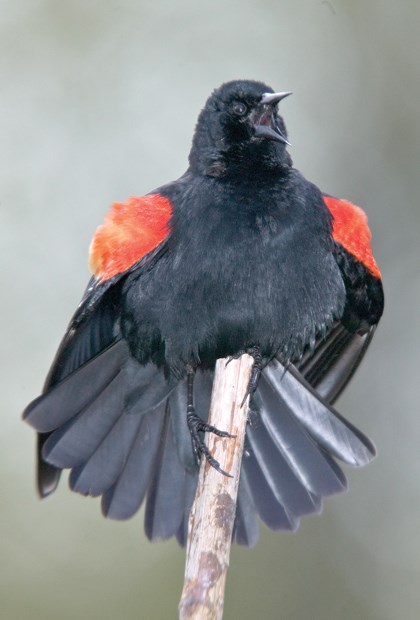Now that the days are getting longer the dawn chorus of early songsters is well underway.
Not only does the robin loudly proclaim its "cheerily, cheerily, cheer up!" (sometimes well before sunrise), but song sparrows, red-winged blackbirds and spotted towhees also join the morning chorus. And then there's the blackcapped chickadee with its "tea-time" (or "cheeseburger?") cheerful notes. It's interesting that the other common chickadee of the North Shore (chestnutbacked) does not have a song like the black-capped. The Steller's jay with its "shack, shack, shack," call also echoes through the woods. The jay is a good mimic and can do a wonderful imitation of the red-tailed hawk. I have been fooled more than once.
Early spring is a wonderful time of the year to be out in nature. Indian plum, red-flowering currant, salmonberry and skunk cabbage all put forth their colourful blooms. When the currant and salmonberry are in flower, we know it's not long before rufous hummingbirds return to the North Shore. It has been suggested that the rufous times its arrival when these plants are in flower as it's an early nectar source. All winter long we've enjoyed watching the Anna's hummingbird with its delightful aerial displays and twittering song and not rufous.
Recently, large flocks of pine siskins have been seen on the North Shore. At the Conservation Area at Maplewood Flats they're often seen feeding in red alder trees. In some years we see good numbers, whereas in other years they're scarce. Species, whose numbers fluctuate from season to season, like siskins, are called irruptive species. These include the American goldfinch, red crossbill and evening grosbeak, to name a few. Check out BirdSource.org for more details.
A good morning of birding at the conservation area can usually produce 40 to 50 species by checking out various habitats, like marine, freshwater (ponds), forest and field. In marine habitats watch for a variety of waterbirds, like herons, ducks, geese and gulls. Ducks include green-winged teal, northern pintail and American wigeon. It's always fun to watch for the rare Eurasian wigeon. Deeper water is where to find scoters, goldeneyes, bufflehead and red-breasted mergansers. Pond ducks include the colourful wood duck and the beautiful hooded merganser.
Morning woods are now full of bird songs like those of the pacific wren, brown creeper and purple finch. The purple finch's song is a rich warbler and something wonderful to hear. Listen also for the calls and tapping of woodpeckers, like the downy, hairy, sapsucker, flicker and pileated. Some birders say they can identify woodpeckers by their tappings.
Always look up to the sky for raptors circling around, like the red-tailed hawk, bald eagle, Cooper's hawk or early migrating turkey vultures.
Swallows, like barn, violet-green and tree, will also be swooping high above for insects. And we await the return of the purple martin later in spring. These birds return from a long migration of thousands of kilometres from South America.
Warm spring days mean butterflies too, like the mourning cloak, Milbert's tortoiseshell and anglewings. Birds, bees and butterflies, they're all a wonderful part of spring and yours to enjoy.
Keep safe.
Al Grass is a naturalist with the Wild Bird Trust of British Columbia, which offers free walks at the Conservation Area at Maplewood Flats on the second Saturday of every month. The next walk will be April 11 starting at 10 a.m. Meet at WBT's site office, 2645 Dollarton Hwy., North Vancouver. Walks go rain or shine.



